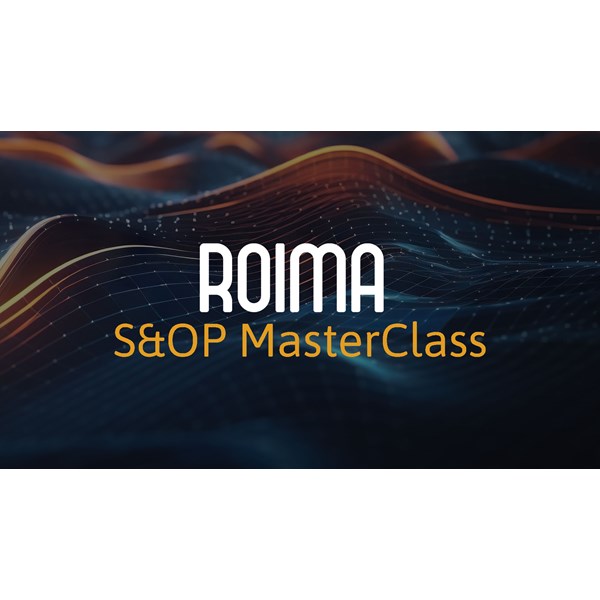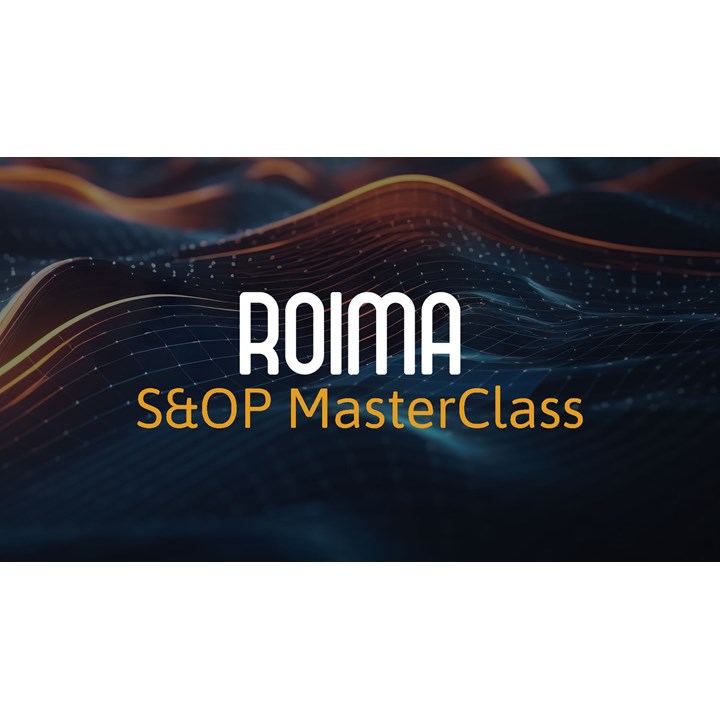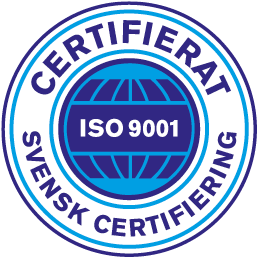S&OP MasterClass™
Seven Steps to Conquer the Dynamic Supply Chain Environment
Welcome to this S&OP MasterClass.
These MasterClasses have the purpose of diving into Integrated Business Planning and Supply Chain Planning in general, hopefully giving you some good inputs on the way.
894043025
This S&OP MasterClass™ is a follow-up to the previous episode focusing on the current changes in the market characterized by crisis.
We have addressed the current obstacles, but how does a company overcome them?
Stefan Sørensen will walk you through the seven-step strategy to overcome present-day challenges and implement a more data-driven and automated approach.
Your host for this podcast is Søren Hammer Pedersen
Link up with Søren Hammer Pedersen here
Link up with Stefan Sørensen here
This podcast is produced by Montanus
In This Episode
Listed below are the most essential timestamps from the podcast episode to make it easier for you to find the topics that interest you.
01:26 Who is Stefan?
02:14 Recap of the previous episode
04:32 Getting the basics right
05:02 The seven steps: Get out of a state of paralysis
08:29 Step 1: List all your obstacles, describe and prioritize your current operating model
16:26 Step 2: Make a prestudy/Analyze your vendor delivery performance
17:09 Prestudy – Analyze the type of issues
18.51 Prestudy – Look at the past two years
19.34 Prestudy – Analysis of internal delivery performance
20.00 Prestudy – Stock balancing
26:18 Prestudy – Full analysis of current footprint
28:16 Step 3: Make a business case
29:47 Step 4: Analyzing the existing supply chain maturity
31:25 Step 5: Implementation roadmap
31:41 Step 6: The final output deciding the vision
32:14 Step 7: Get started on your transformation journey
Full Episode Transcription
Søren [00:09]:
Hello, everybody. Warm welcome to this S&OP Masterclass from Perito Consulting. My name is Søren Hammer Pedersen, and I’ll be your host for this podcast. The purpose of these S&OP master classes is to give you some insights into how we work with supply chain planning with our clients, and hopefully give you some tips and tricks, some perspectives that you can use in your own supply chain planning and improve the performance in your companies.
Søren [00:38]:
Today’s topic is a follow-up on our last podcast, where we discussed that supply chain professionals really need to do something different, need to have a new perspective on supply chain management if they want to succeed in the future. And today, we’re following up, getting a bit more hands on, giving you seven steps on how you can, actually, get the basics right if you want to make a transformation in your supply chain planning.
Søren [01:04]:
And again, today, I have invited my very good colleague, Stefan Sørensen, into the room to give his perspective and his experience in these seven steps on the transformation. Warm welcome again, Stefan.
Stefan [01:17]:
Thank you very much.
Søren [01:26]:
And again, it’s not everybody that has listened to the first podcast, so just to benefit for everybody, could you, just, brief introduction, who is Stefan? And what’s your experience?
Stefan [01:36]:
Sure, Thank you very much. So, I have a background in business consulting and ERP implementations, and business intelligence and planning solutions. So, I’ve worked with that, basically, for 20 years. So, I have a wide range of experience, both from the business side, but, also, going all the way back to the nitty-gritty details of IT implementations.
Søren [02:04]:
Perfect. So, you’re seeing a lot of companies wanting a transformation.
Stefan [02:07]:
Yes.
Søren [02:09]:
And let’s see what your views are on how to fix that.
Stefan [02:13]:
Yeah.
Søren [02:14]:
Before we dive into the seven steps, which is, basically, the basis of this podcast here today. I think just for the listeners, again, it could be good to just have a quick recap into why it is that we think that a change is due in many supply chain professionals view on supply chain management.
Stefan [02:35]:
Sure. So, you can say mean operations has always had focused on efficiency and optimization, et cetera, but there’s a huge difference in optimizing driving down a straight road, without too many bumps and then optimizing your supply chain in a situation we’ve had for the past, let’s say, three to four years, where there’s been the COVID crisis and now, recently, the scarce access to capital, et cetera, inflationary pressures and so on.
Stefan [03:11]:
And we talked about the last podcast that, basically, from a supply chain perspective, going from, almost, a pure delivery performance perspective to also looking very, very hard on the networking capital side that, basically, from a supply chain perspective, corresponds to turning the wheel 90 degrees left or right.
Stefan [03:34]:
And maybe that’s just the new normal that we’ll see, a lot more of these 90 degree turns from year to year. And basically, we need to set our supply chain, both processes and IT solutions and organizations, into a mindset where they’re able to do that without having to do projects every time there is this 90-degree turn. So, your systems and processes need to be, basically, adaptive to these changes in focus. Yeah.
Søren [04:06]:
Yeah. So, basically, we established that change is do, and of course you at home, if you want to dive more into that, we have another podcast to really broaden out that topic. But let’s set the scene here. I think two things you said the last time that we set off on today is, one, just get started, not wait, but get the basics right.
Stefan [04:32]:
Yes.
Søren [04:32]:
And it’s the basics, right, that we really try to dive into today, because if you’re a supply chain professional, where to start is the big picture. And even though we really advocate that you should just get started, not wait for your next ERP system or whatever, then we also say at the same time that you have to do the right things. And I know you have prepared a seven-step plan here to make that transformation. So, let’s try to dive into that and what to do in practice here.
Stefan [05:02]:
Yeah, and I’m sorry if, after, we’ve gone through the seven steps, people… The listener might not think that this is, well, “This is nothing new, this is not rocket science.” But the reason why we’re bringing it up is, simply, because we’ve seen it done wrong so many times in our experience. So, what we’ve seen done wrong is, basically, we’ve seen supply chain organizations, basically, go into a state of paralysis. This paralysis coming from the fact that, maybe, their ERP landscape is not as they would like it to be. So, they need to do a reimplementation of their ERP landscape.
Stefan [05:39]:
Maybe they’re in a constant firefighting mode, which is not unusual for operations, constant firefighting mode, and they never, really, think they have the bandwidth to move to this next shangri-la of processes where everything is IT driven and rule based, et cetera. Or they might have trouble with their master data, so we really need to clean our master data before we can start any roadmap on the road to a more efficient supply chain. So, all of this corresponds to a state of paralysis and that’s, basically, what we’re advocating to get over and simply get started.
Stefan [06:20]:
But I think the seven points will, basically, tell you, okay, “What does it mean to get started? What do you need to get right from the start?” And again, like we did in the last podcast, I would say point number zero, doesn’t count. But the point number zero is, that you need to be very realistic around whether you are able to drive this process on your own, or whether you need assistance from an external party. And the reason why we call it ‘point number zero’ is that, we know that it’s self-serving coming from a potential partner to say this, but you really need to know whether you have access to the right capabilities.
Stefan [06:58]:
And the right capabilities, both being on the business consulting side, being able to go in and analyze your operating model together with you, as a client, but also understand the very technical side because, as we also mentioned in the last podcast, this is very much an IT driven exercise, as well.
Stefan [07:20]:
All of the enablements you’re going to get in this new journey for the supply chain, is going to be enabled by IT and solutions that fit in with your existing landscape. So, find the trusted partner that can take you, basically, a spare with on all the different areas of these initiatives. And then, it’s also important to treat it like you would do when you select a new ad agency, for example.
Stefan [07:52]:
So, see it as a partnership that goes the next four, five, even longer years, because this is a journey and it’s not completely well defined from the beginning what type of initiatives you’re going to do. So, you need to have the mindset that you have a partner who can help you on all the different areas if don’t have the capabilities in-house. Yeah. So, should we get started on-
Søren [08:20]:
Yeah, let’s dive in to the first point here, being… Okay, where do a professional start here?
Stefan [08:28]:
Yeah.
Søren [08:29]:
First steps.
Stefan [08:30]:
And I would say the first step, it might not be so intuitive, but I would actually say that it’s very important for the business on their own before they invite any partners in, to try to describe in their own words, with their own understanding, what are their view on their current operating model? What’s the status? And where would they like to go?
Stefan [08:53]:
So, listing all the different obstacles, et cetera, in their own perspective before they invite anybody in, and try to document that, because it’s easy to lose track of what their own view of the situation is as soon as external parties enter the game. So, I say that’s an important step, number one, is try to describe and prioritize your own view on your current and your future operating model.
Søren [09:20]:
Yeah. So, how would you go about doing that in practice? You would invite in, of course, stakeholder, but is it fixed on the paints of the supply chain at the moment, or where we perform best or how would you-
Stefan [09:36]:
It’s, basically, a bit of both. So, both describing, objectively, what does our operating model… What principles are we driving our operations from? Simple things like, what is our footprint like? Why are we producing in these sites and distributing via these sites, et cetera. Is there any, obvious, ideas on how to make our footprint of factories and distribution centers, et cetera, more efficient?
Stefan [10:01]:
Is there anything with our product portfolio that could be sanitized, et cetera? So, all these initial ideas before anybody, externally, enters the room, try to describe that in your own words. And where would you, ideally, want to be in five, 10 years with your business? Of course, taking into account all the different other strategies in your company like sales strategies, or R&D strategies. So, you need to have a full, holistic picture of your business.
Søren [10:28]:
Yeah. And I guess, also, one thing I stumble upon quite often is, that you also need to involve the C level here in that script, because what are, at the moment, the critical business values that we, as a supply chain, need to attend to and our outcomes need to. So, I guess you need to have that perspective. Is it still profitable growth? Or is it capital? Or what is it that, really, is the key drivers or service levels, whatever, for our business in the next one, two, three years down the road?
Stefan [10:59]:
Yeah, obviously, on top of the ideas for the operating model, both now and the future, you need the direction from the board of directors to, basically, indicate what their view is, so you’re not coming up with some pie-in-the-sky.
Søren [11:15]:
Yeah, but sometimes it might, actually, be a good idea to ask them because, surprisingly enough, in my experience, some companies… People guess and it might not be right. So-
Stefan [11:27]:
So, keeping alignment with your board along this journey is, of course, extremely important.
Søren [11:32]:
Yeah. So, step number one, do your homework.
Stefan [11:35]:
Yes, exactly.
Søren [11:37]:
Yes.
Stefan [11:38]:
Then point number two is… And this is, basically, going back to our methodology, as well. So, typically, when we engage with a new client, I would say 90% of the cases, because we must recognize that the client base can be in many different maturity levels but the model here, actually, works in all cases, even if it’s a very advanced supply chain or whether it’s a fairly low level of maturity supply chain.
Stefan [12:03]:
But the point number one is, basically, to conduct, what we call, a pre-study. And that’s, of course, easy to say, but we’ll get into the details of what that actually is comprised of. Basically, a pre-study is a bottom-up analysis of your supply chain, so not just a fancy management consulting analysis which delivers a PowerPoint slide at the end, that you can take to your board and present.
Stefan [12:30]:
It’s basically a very data driven analysis of what’s the situation in our supply chain at the moment. And the pre-study, basically, covers five different functional areas. Of course, you can always discuss whether it should be split up even further, but now we’ll highlight the five different areas.
Stefan [12:49]:
Area number one is the demand planning side. So, basically, diving into what is our current… Because no matter whether you think you have it or not… You have an approach, and you have a demand plan or… You have a demand plan today, whether it be an Excel sheet that’s done in sales or in finance, or on operations by themselves, you have a demand plan.
Stefan [13:12]:
So, what’s the accuracy of that and how is it performing? And what are the principles behind it? So, basically, are we planning by customer and material or just by market and material, et cetera, and what’s our methodology for doing the demand plan?
Søren [13:32]:
Yeah, and I guess when you say “demand plan”, then if we talk about the pre-study or the analysis that we conduct here, what would you dive into there? How accurate are we in predicting our sales, or what are the dimensions here that you should-
Stefan [13:53]:
The way we approach it is, basically, to go in and try to do a competing demand plan. So, with our principles, our methodology, et cetera, of course, educated by the methodology that the customer is already using, then we’ll try to do a demand plan and see if we can push the level of forecast accuracy even higher than they have today.
Stefan [14:16]:
Both, introducing and generating ideas for new approaches, new methodologies to do the demand plan, but also to verify that how mature is the process, actually, the current process that have today. It also reveals, and that’s the same for the other points, it also reveals, exactly, how mature is your current IT landscape.
Stefan [14:38]:
So, your ability to deliver data to do this bottom-up driven material-by-material demand plan. How well are we able to generate that quickly will tell you something about your maturity on the data side. But, of course, most importantly, it will indicate whether you have a significant potential in this increase forecast accuracy or not.
Søren [15:04]:
And I guess one thing, of course, is how much can we improve things that… But I guess, here, that’s also really valuable insights into an explanation. Why are we here today? So, is there, just an example, seasonality that we are not picking up or something in our data that’s wrong, or in the behavior that comes from the demand planning. Analysis, as well.
Stefan [15:28]:
That will also be uncovered in this pre-study. It will also uncover one of the hot topics in demand planning today, is demand sensing and the use of machine learning, et cetera, introduced in the demand planning process where the clients, in general, don’t have the maturity level to do it on their own.
Stefan [15:47]:
Then we would be able to, or another partner would be able to introduce new ideas, new methodologies, to show whether it would, actually, be able to add to your forecast accuracy, in general. So, all of that would go into the analysis. And again, to highlight, this is a bottom-up analysis going into the detail. It won’t only deliver high level results, it will actually tell you exactly what products you have issues on, et cetera.
Søren [16:16]:
Yeah.
Stefan [16:18]:
Then if we move to the second functional area, I should reiterate that we’re talking about five functional areas within the pre-study.
Søren [16:25]:
Yeah.
Stefan [16:26]:
The second area is to analyze your vendor delivery performance because as we’ve seen, especially, in the past two, three years, there’s huge, huge difficulty in most supply chains on the supply side. And, historically, we’ve had a lot of focus, a lot of man hours going into the demand planning side. But the reality is, that if the supply side is fluctuating wildly compared to our master data in our system, lead times, et cetera, then that can have, at least, or even more impact on poor performance in your internal supply chain.
Stefan [17:09]:
So, not just delivering a report of your vendor delivery performance, but also analyzing what type of issues, what exact vendors, what product or component classes are you having specific problems on, et cetera, to generate ideas. And that’s, of course, the analysis part, but there’s also the part that goes into idea generation on… Is it possible to integrate our processes even deeper into the supply side? Meaning, sharing forecast, that’s an obvious point.
Stefan [17:46]:
But how far can we go in that integration? And that, of course, depends hugely on what the supply landscape looks like from a certain client point-of-view. Do we have 2000 suppliers of… And are we a small player in their view or a big player? So, all of those considerations goes into the analysis to generate ideas for the future supply chain strategy. But, I guess, here you also get a data driven view on your supplier’s performance. Because it’s important to state that everything we do in the pre-study is data driven. So, all ideas generated, would be pointing to a specific analysis in the pre-study.
Søren [18:31]:
So, a benefit here would be that, we as a company might have a perception on our supplier performance and lead times, and things like that but here, you actually, if you perform this type of analysis, would get hands on knowledge, are we correct? And how much does it actually fluctuate? So, I’m going away from gut feelings, to actual data on things.
Stefan [18:51]:
Exactly. Especially on the vendor performance. The obvious analysis is just to go in and look through the past two years, purchase orders coming in from vendors. What lead times? What’s the variation in lead times, et cetera, and how can we use that information in our internal optimizations?
Stefan [19:08]:
Because, as we do with stock optimization on the demand side, we look at our ability to foresee the demand fluctuations when we determine the optimal stock levels, but at the same time, we’re also able to look downstream to our suppliers and see those supply fluctuations should also be taken into account in the optimal stock levels.
Stefan [19:34]:
Yes. Then the third functional area within the pre-study, is basically an equivalent analysis of the internal delivery performance, and not the internal delivery performance, but our performance against our customers, which is also important. Because that goes into the fourth functional area, which is, basically, stock balancing.
Stefan [20:00]:
So, for stock balancing you, of course, need a stocking strategy, which is, basically, based on a targeted service level. And to set a targeted service level, you also need an idea of what is actually the realized service level we currently have against our customers. And are we having low performance in general? Or are we having low performance in the past year because of certain situations? So, we need that whole basis for decision making when we go into point number four, which is the stock balancing part.
Søren [20:36]:
Yeah.
Stefan [20:36]:
And then for the stock balancing part, it’s important to state that the situation has changed quite a bit in the last two, three years, as we touched in the previous podcast, where the focus is hugely on how much capital we have tied up in the stock and less, of course, the delivery performance is still hugely important, but now we’ve equally… As much focus on how much stock we have tied up. And even some customers have specific, sort of, thresholds or ceilings on how much are they allowed to tie up in stock from their boat.
Søren [21:18]:
Yeah. So basically, if you’re looking for a silver bullet for a C-level and especially CFO attention, this is the area that you should focus on. I think, virtually, every CFO we talk to at the moment have this attention towards the inventories and how much cash, of course, we are tying up at the moment.
Stefan [21:38]:
And depending on how far down you go into this pre-study, you can go into the whole stock balancing analysis. You would go in and prescribe certain, you could say, reduce the stock you’ve tied up from different initiatives. What’s our strategy with regard to, maybe, sanitizing our product portfolio? Simplifying… Because, as we know, we’ve come from a situation where we could, basically, sell everything and that has a standard effect that your product portfolio will grow in complexity and, of course, the supply chain just has to keep up.
Stefan [22:18]:
But now that the focus has shifted to focus on how much capital you’ve tied up and stock, then the supply chain is, sort of, left with the bill. And part of the solution there is, basically, to sanitize your product portfolio, maybe, which will subsequently sanitize your need for components in the other end.
Søren [22:41]:
So, what you’re saying is that, in many of these analysis towards the inventory and the stocks, you will also see some recommendations of going from a situation where everything is made to stock, basically, let’s just get it in. That we will have a number or series of our products that will be made to order that just… We’re changing a service level, we’re not promising as much to the clients.
Stefan [23:05]:
Exactly.
Søren [23:05]:
So, we’re just making in once they order here now.
Stefan [23:08]:
So, it’s, basically, revisiting the whole tale of products, which is closer to not being profitable now than they were two years ago.
Søren [23:18]:
Yeah.
Stefan [23:18]:
So, that’s just point number one. But then we have, also, of course, an obvious one is to scrap or sell off stock to simply get the networking capital down. That’s an obvious one. Then we have the next point, is the ability to, maybe, if you have a multi-level supply chain returning excess stock from your downstream locations, some organizations, they already have a standard process for returning goods back into the central warehouses. Some companies don’t. If you don’t have it, there’s a big chance that you’re going to have debt or excess stock lying around, out in the downstream locations or in the distribution centers.
Stefan [24:02]:
And if you move those back in your supply chain, they, basically, increase the likelihood that you will be able to use it in other situations. Of course, that has to be evaluated based on the cost of those materials, et cetera. So, that’s returning stock. We also have the ability to, in some cases, just like our clients are being pushed by their customers, then our clients could also push, either the customers or the vendors, to keep the stock or, basically, increase their flexibility in when we receive the stock.
Stefan [24:42]:
Of course, then, as we talked about before, we also need to look at the stocking strategies, in general. If we have this cap on how much stock value we’re allowed to tie up from our bots, then one solution could be to look at targeted decreases of the delivery performance. So, basically saying, okay, but these products would… Generally, we want to be at a 97% service level, but for these targeted products that we only deliver once in a while, then we might reduce both, the service levels and thereby the stock that we’ve tied up.
Søren [25:21]:
And I guess it also goes the other way, in the sense that, we also want to make money. So, I guess, we can have the situation where we actually want to increase the stock on some items because, actually, it’s a bit of business case for us.
Stefan [25:35]:
So, it is a rebalancing exercise. It’s not just a stock, sort of, reduction exercise.
Søren [25:41]:
Yeah.
Stefan [25:42]:
Yes. And then we have companies where they have a huge amount of backlog orders and, of course, shipping those backlog orders out, depending on what the reason for the backlog, of course, is, if it’s because you’re missing components, then it’s not completely up to you. But, basically, we have client examples where they have huge amount of service orders in backlog and, basically, just completing those instead of taking new orders in. That’s one way to reduce stock, but actually keeping the activity level.
Stefan [26:18]:
So, that’s just a few things you could look at when we talk stock balancing. The fifth point we’re going to, sort of, analyze in a pre-study is, basically, to go in and do a full analysis of their current footprint. So, like we talked about before, are we producing the right products at the right places? Are we having the right footprint with regard to distribution centers? Where are we putting the decoupling points of the stock? To minimize the stock but have the necessary service level and lead times, et cetera. So, that’s also part of the analysis.
Søren [26:57]:
Yeah. I guess it’s here, that once we look at the supply chain footprint, that linking back to, I think, very interesting, around the inventories and the whole stock analysis there, that things come into play that it’s hard to change. For instance, goods and transit is a lot that, some, at least, the companies struggle with at the moment.
Søren [27:18]:
I guess you will get that overview when you look at the footprint, as well. How can we, in time, adapt, maybe, to avoid some of these situations that we are in at the moment?
Stefan [27:28]:
Yes, that would be part of the footprint analysis, and sometimes the footprint analysis also…. Yeah.
Søren [27:37]:
Got that. So… But, good. So, we made the analysis, now we know where th-
Stefan [27:46]:
That was a complicated ‘point number two’, with a lot of sub points. But the third point is, basically, trying to… All of these outputs from the analysis covering the five functional areas, and just to reiterate, we have the demand planning improvements, we have understanding of our vendor delivery performance, we have our delivery performance against our customers, and we have the whole stock balancing exercise, and finally, the focus on the footprint. Those are the five areas of analysis.
Stefan [28:16]:
Then the third main point is, that we go into the business case and try to formulate all the findings we’ve come across during the pre-study, we’ll capture that in a business case, both to capture the high level performance figures as they are right now, but the pre-study will also have, sort of, indicated what the potentials are. And this is both the theoretical potentials, but also the real potentials.
Stefan [28:48]:
So, basically saying, well, our optimal stock levels might be at the 300 million euros and currently we’re at the 400 million. That would be the theoretical optimal, optimum. And then, a range of reasons why that gap of a hundred million is there. So, trying to capture that in a business case format so you know exactly before you start on the roadmap… This four, five year roadmap to improving your supply chain, you exactly what your baseline is and what you are moving against, theoretically.
Søren [29:23]:
Yeah, and I guess this is a point that, even though that you, as a person, might want to skip it, you’re probably not allowed to, because once you want to set this for information, every C-level you’re going to touch upon will ask for this, to some extent. What kind of transformation and what do we get out of it? What are the problems we’re solving?
Stefan [29:44]:
Exactly.
Søren [29:46]:
So, you need this step, I guess.
Stefan [29:47]:
Yeah. Then if we’re moving to the fourth point, which is also an output from the pre-study, which again, I reiterate is a very detailed exercise. It’s not a long, from a calendar point of view, not a long exercise, but it’s a very detailed output you get from that pre-study. The fourth output is, basically, analyzing the current supply chain maturity. So, analyzing your organization… Organizational maturity with regard to supply chain management.
Stefan [30:17]:
And that is, basically, split into two sections saying we need focus on, “What’s our current capabilities on our people and organizational side and what’s our capability with regard to solutions and processes?” So, those two, you will get a clear picture out of just doing the basic pre-study as it is, what’s our ability of our own people to actually keep track of what’s happening during that process, that will tell us something about their maturity level. Communicating between the different functional areas during the pre-study will tell us, “Okay, what’s our organizational maturity? How well are they receiving the conclusions? How well are they playing in that process?”
Stefan [31:00]:
But also, as I stated before, on the solutions and processes side, we will get a very good picture of what’s our ability to generate the necessary data output to do the analysis, and what’s our ability to analyze that data. So, we will get a very good picture of the current supply chain maturity and then also have, of course, an idea for the gap to watch the…
Søren [31:25]:
Yeah, and I guess, also, the input to… Let’s say we decide on this transformation, then most would do some, kind of, implementation roadmap.
Stefan [31:34]:
Exactly.
Søren [31:35]:
You need that information in there because that, of course, will guide how we implement this.
Stefan [31:41]:
Yeah, and that comes into point number six, which is, basically, the final… You could say, the final output from this whole process is very… Basically, defining based on the pre-study, defining the vision, which leads to the defining the strategy, which leads to defining the high-level roadmap. And I stress that it’s a high-level roadmap. We don’t want to do long, 100-page strategy paper, describing each initiative in detail, because our point number seven, is you need to get started on the journey.
Stefan [32:14]:
And doing a lot of detail analysis on how all the different initiatives are linked, et cetera, that’s simply going to lead to the risk of even further paralysis, of not wanting to move ahead because there’s so many things that are wrong, and where we’re going to start, et cetera. So, the important thing is that you have the high-level roadmap of these initiatives and then you pick very pragmatically, pick the ones that makes sense to start on and then get started.
Søren [32:47]:
I think that’s very sound advice at the last point.
Stefan [32:51]:
Yeah.
Søren [32:51]:
I think, just to elaborate a little bit about why we have this… Just get started, I guess it’s also because, in our experience, you can have the best laid plan for this, the most detailed planned within this area, and three months down the road, you get wiser on some of the points, and you need that flexibility to make the best decision, not the ones in the pretty PowerPoint, but you need the flexibility to make the right decision and not the decision you plan for. So…
Stefan [33:21]:
Exactly, because as we’ve stated multiple times, also in the previous podcast, the reality is going to change. That’s the whole point of this, that if the supply chain focus changes six months down the road, corresponding to this 90-degree turn, the same thing is going to happen to your strategy or, at least, the prioritization of your different strategy initiatives are going to change, completely, maybe every year, at least.
Søren [33:48]:
I think, hugely, interesting seven points here but, maybe, as a final point, we conducted now the seven points, we are ready to go. Just a few points from your perspective, what can companies gain from making this transformation? What are you looking at the moment?
Stefan [34:11]:
The main point is that, as we talked about in the previous podcast is, all of what we’re talking about here is, basically, increasing the organization’s ability to execute your supply chain decisions. So, making that more efficient or even manageable because, as we also talked about before, some organizations are simply not able to steer the ship, or steer the organization 90 degrees, even if they wanted to.
Stefan [34:41]:
So, they simply don’t have the capability. So, simply introducing that capability, but then also do it efficiently. That’s what they’ll get out of it. And that would be true even if we were driving down the straight road, as I said in the beginning, or as it is right now, that it seems like we’re jumping from crisis to crisis, which is the reality.
Søren [35:04]:
So, the basic message, carry out these seven steps, make sure you have the basics right because these seven step will actually make sure that your desired business outcome from the company is balanced with your supply chain outcome, afterwards.
Stefan [35:21]:
Yes.
Søren [35:21]:
And then get started, as you said. I think… Very, very good input, Stefan, and thank you very much for… I think time is running out for this podcast. I think, final point for me here, if you or a listener could be wondering is… Listening to these seven steps, “Oh, no. This is taking a year… A year and a half.” I think, just wanted to make the point that this should be able to be done in four to six weeks, if you set your mind to it.
Søren [35:53]:
So, it’s not a huge complex thing to do this homework or this preparation here, but the consequences of not doing it can be quite severe, in our opinion. So, I think that’s also a valid point to have here in the end. But thank you very much to you, Stefan, and for you listening out there, thank you for joining in today, here.
Søren [36:17]:
I hope you found some good inspiration in these seven steps. If you want to hear more about us or Perito Consulting, check out our website or reach out to us. We are more than happy to talk about how this could be in your organization. But other than that, thank you for tuning in and have a great day out there.














